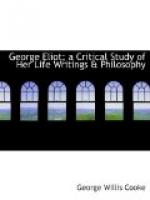Was this question a prophecy? It indicates that the writer’s attention had already been directed to the richness of this material for the purposes of the novelist. After reading these words we see why she took up the common life of the English village as she had herself been familiar with it from childhood. In order to be true to her own conception of the novel, there was no other field she could occupy. That she understood the picturesqueness of this form of life no reader of her novels will doubt, or that she saw and understood its capacities for artistic delineation. The opening paragraphs of her Westminster Review article on the “Natural History of German Life” afford further evidence of her insight and wisdom on this subject. They also afford evidence of her hatred of the conventional and the artificial in art, literature and life. The spirit of imitation and mannerism common to the eighteenth century was in every way repugnant to her. She could have had only contempt for the literary art of a Pope or a Boileau. The nature of her realism, and the conception she had of its importance, may be understood from these paragraphs, for in them she has unfolded her theory more clearly than in anything else she has written, and with that genius for sympathetic description which is so marked in her novels.
How little the real characteristics of the working-classes are known to those who are outside them, how little their natural history has been studied, is sufficiently disclosed by our art as well as by our political and social theories. Where, in our picture exhibitions, shall we find a group of true peasantry? What English artist even attempts to rival in truthfulness such studies of popular life as the pictures of Teniers or the ragged boys of Murillo? Even one of the greatest painters of the pre-eminently realistic school, while in his picture of “The Hireling Shepherd” he gave us a landscape of marvellous truthfulness, placed a pair of peasants in the foreground who were not much more real than the idyllic swains and damsels of our chimney ornaments. Only a total absence of acquaintance and sympathy with our peasantry could give a moment’s popularity to such a picture as “Cross Purposes,” where we have a peasant girl who looks as if she knew L.E.L.’s poems by heart, and English rustics whose costumes seem to indicate that they are meant for ploughmen with exotic features that remind us of a handsome primo tenore. Rather than




